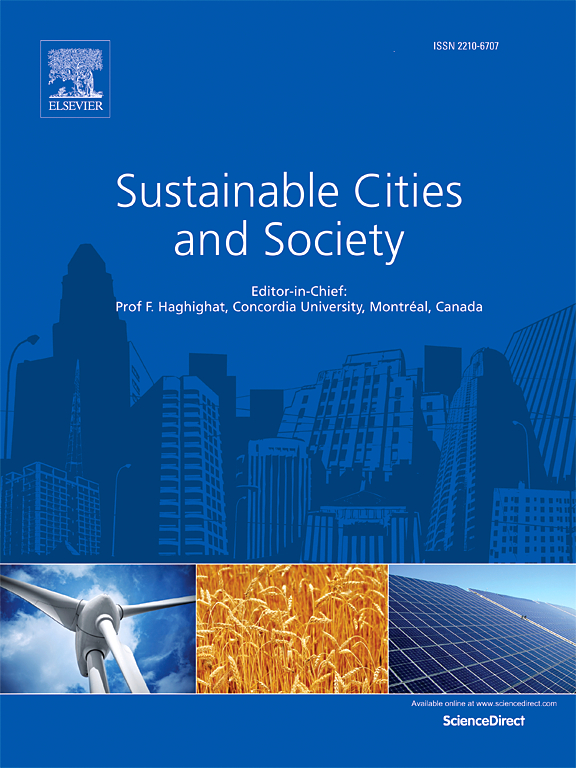夏季地表城市热岛凝聚的全球格局与驱动因素
IF 10.5
1区 工程技术
Q1 CONSTRUCTION & BUILDING TECHNOLOGY
引用次数: 0
摘要
随着全球城市化进程的推进,地表城市热岛效应日益显著,对城市宜居性和公共卫生构成了重大挑战。SUHI凝聚力(suhc)量化了SUHI效应的空间聚集和连通性模式,为其结构组织提供了关键见解,并确定了热调节的战略重点。然而,SUHIC的空间分布和时间趋势在很大程度上仍然未知,其控制仍不清楚。为此,量化2003 - 2022年全球城市SUHIC的空间特征和时间格局,并进一步探讨其驱动因素。有两个主要发现总结如下。(1)全球城市中,高水平的城市在白天和夜间分别占75%和65%。SUHIC的地理分布表现出显著的空间差异和气候差异,在干旱气候区黏聚力最低。在白天和夜间,SUHIC与△EVI呈负相关,与△ISA和SUHII呈正相关。(2)从时间上看,2003 - 2022年全球城市SUHIC呈上升趋势。增加、减少和稳定趋势分别占全球白天的61%、25%和14%,而夜间分别占55%、24%和21%。在白天和夜间,SUHII和SUHII之间的相似趋势分别为55%和51%。约55%的城市在白天的SUHIC和△EVI(植被指数增强)之间呈现相反的趋势。也就是说,城乡植被差异越大,城市区域内白天SUHI的强度和凝聚力就越大。本研究旨在加深对苏州城市健康指数聚集与连接模式的认识,为优化城市规划、实现城市可持续发展提供理论支持。本文章由计算机程序翻译,如有差异,请以英文原文为准。
Global patterns and drivers of summertime surface urban heat island cohesion
With the advancement of urbanization globally, the surface urban heat island (SUHI) effects have become increasingly pronounced, posing substantial challenges to both urban livability and public health. SUHI cohesion (SUHIC) quantifies the spatial aggregation and connectivity patterns of SUHI effects, providing critical insights into their structural organization and identifying strategic priority points for thermal regulation. However, spatial distribution and temporal tendency of SUHIC remain largely unknown, and their controls are still unclear. Therefore, spatial characteristics and temporal patterns of SUHIC from 2003 to 2022 across global cities were quantified and their drivers were further explored. There are two major findings summarized as follows. (1) The high level of SUHIC accounts for 75 % and 65 % of global cities at daytime and nighttime, respectively. The geographical distribution of SUHIC indicates significant spatial variations and climate differences, with the lowest cohesion is observed in the arid climate. SUHIC is negatively correlated to △EVI while positively correlated with △ISA and SUHII during both day and night. (2) Temporally, SUHIC of global cities shows an increasing trend from 2003 to 2022. The increasing, decreasing and stable trend account for 61 %, 25 % and 14 % at daytime worldwide, compared to 55 %, 24 % and 21 % at nighttime, respectively. The similar tendency between SUHIC and SUHII accounts for 55 % and 51 % at daytime and nighttime, respectively. About 55 % of cities exhibit an opposite trend between daytime SUHIC and △EVI (Enhanced Vegetation Index). Namely, higher vegetation difference between urban and rural areas results in greater intensity and cohesion of daytime SUHI within urban areas. This work is proposed to enhance the understanding of the aggregation and connectivity patterns of SUHI and to provide theoretical support for optimizing urban planning for sustainable city development.
求助全文
通过发布文献求助,成功后即可免费获取论文全文。
去求助
来源期刊

Sustainable Cities and Society
Social Sciences-Geography, Planning and Development
CiteScore
22.00
自引率
13.70%
发文量
810
审稿时长
27 days
期刊介绍:
Sustainable Cities and Society (SCS) is an international journal that focuses on fundamental and applied research to promote environmentally sustainable and socially resilient cities. The journal welcomes cross-cutting, multi-disciplinary research in various areas, including:
1. Smart cities and resilient environments;
2. Alternative/clean energy sources, energy distribution, distributed energy generation, and energy demand reduction/management;
3. Monitoring and improving air quality in built environment and cities (e.g., healthy built environment and air quality management);
4. Energy efficient, low/zero carbon, and green buildings/communities;
5. Climate change mitigation and adaptation in urban environments;
6. Green infrastructure and BMPs;
7. Environmental Footprint accounting and management;
8. Urban agriculture and forestry;
9. ICT, smart grid and intelligent infrastructure;
10. Urban design/planning, regulations, legislation, certification, economics, and policy;
11. Social aspects, impacts and resiliency of cities;
12. Behavior monitoring, analysis and change within urban communities;
13. Health monitoring and improvement;
14. Nexus issues related to sustainable cities and societies;
15. Smart city governance;
16. Decision Support Systems for trade-off and uncertainty analysis for improved management of cities and society;
17. Big data, machine learning, and artificial intelligence applications and case studies;
18. Critical infrastructure protection, including security, privacy, forensics, and reliability issues of cyber-physical systems.
19. Water footprint reduction and urban water distribution, harvesting, treatment, reuse and management;
20. Waste reduction and recycling;
21. Wastewater collection, treatment and recycling;
22. Smart, clean and healthy transportation systems and infrastructure;
 求助内容:
求助内容: 应助结果提醒方式:
应助结果提醒方式:


